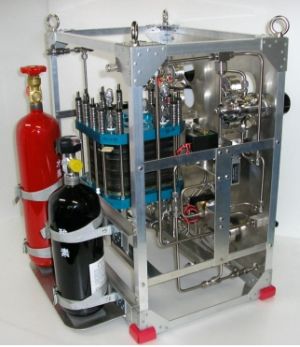Purpose of the flight and payload description
The objectives of the flight were to perform a test of a fuel cell system to verify its performance in the stratosphere as well to analize the performance of an automatic system to control the end of flight.
The fuel cell system -which can be seen in the image at left- was composed by the fuel cell, a gas distribution subsystem, and electronic subsystem and was built to be used in future long duration flights of superpressure balloons. It's core were a number of fuel cells stacked together, which generated electricity by converting chemical energies of hydrogen and oxygen into electrical energy, as long as it is supplied with fuels and oxidants. In a proton exchange membrane (PEM) fuel cell, hydrogen was ionized to proton at the anode. Protons and electrons passed through the PEM and external circuits, respectively, and arrived at cathode electrode where they react with oxygen. Water was generated at the cathode electrode as a reaction byproduct. The stack consisted of 16 cells with an active area of 162 cm2 and weighed 18.6 kg. Non-humidified hydrogen and oxygen were supplied to the fuel cell stack from a gas distribution subsystem. The non-external humidified operation of the PEM fuel cell stack was realized by introducing hydrogen and oxygen from opposite directions.
The electronic subsystem consisted of electromagnetic valves, an electronic load, mass flow controllers, amplifiers, transducers, a data logger, heaters, and a battery.
The entire gondola had a mass of 40 kg and measured 50 x 50 x 60 cm.
Details of the balloon flight
Balloon launched on: 8/30/2007 at 6:02 jst
Launch site: Sanriku Balloon Center, Iwate, Japan
Balloon launched by: ISAS / JAXA
Balloon manufacturer/size/composition: Zero Pressure Balloon model B50 50.000 m3
Flight identification number: B50-50
End of flight (L for landing time, W for last contact, otherwise termination time): 8/30/2007 at 9:15 JST
Balloon flight duration (F: time at float only, otherwise total flight time in d:days / h:hours or m:minutes - ): 3 h 20 m
Landing site: In the Pacific Ocean, 20 km from Iwate. Balloon near Towadako
The balloon was launched from the Sanriku Balloon Base in Iwate, at 6:02 local time on August 30th, 2007, and after a succesfull flight of near three hours, it was separated from the payload near 9:00 local time. However the balloon instead to burst remained at flight altitude. While the payload landed in the sea 20 km from Iwate coast, the descending balloon (measuring 50 meters in diameter and with a weight of near 300 pounds) crossed the seashore and entered overland, forcing aviation authority to divert 7 planes from the landing area. It finally hit the ground near a town called Towadako.
Next day JAXA published in their Japanese home page their apologies by the incident and promised to start an investigation on the causes of the failure.
On regard the fuel cell system test, it showed an almost stable performance during the demonstration flight.
External references
- A Demonstration Flight of a Fuel Cell System for Super-Pressure Balloons 26th International Symposium on Space Technology and Science
- Details of the mission (in Japanese) ISAS website
- Japanese Balloon Program J. Phys. Soc. Jpn. 78 (2009) Suppl. A, pp. 97
- Official word on the balloon termination incident ISAS website
2701If you consider this website interesting or useful, you can help me to keep it up and running with a small donation to cover the operational costs. Just the equivalent of the price of a cup of coffee helps a lot.


